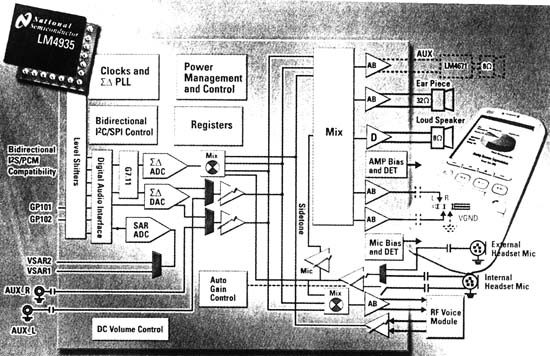Different devices (such as cell phones, in-car kits) provide and reconfigure different sources and outputs for audio requirements.
This article refers to the address: http://
These sources may include baseband, application processor, media decoder, RM radio module, built-in microphone, and hands-free microphone. Either of these sources may be in different formats or domains (analog or digital). For a wide range of input source options, there are many output options: single earphones, stereo headphones, single speaker output, stereo speaker output, and line out.
Audio subsystem
NS's LM4935 single-chip subsystem (Figure 1) provides all the sources and outputs needed to design the array and application modules. Its RF voice module can be used for GSM baseband, and AuxL/AuxR analog line output can be used for FM radio module. The I2S and PCM digital inputs and outputs can be configured to interface or connect different DSP/media decoders. The speaker inputs can accommodate single-ended or differential speakers and provide bias voltage if needed.
The key feature is that one mode of the digital interface is bidirectional I2S, which facilitates playback and recording of digital sources. Imagine that the telephone line input is connected to a CD player or radio as an external source, and the DSP inside the phone performs MP3 encoding, and then newly generates a new usage model that immediately reproduces the generated MP3 media instead of downloading it from an external PC.
A single 1.3WD class amplifier with or without a filter at the output, a dedicated amplifier for headphones, and an auxiliary output for stereo operation. Although the internal structure of this device can handle stereo audio, there is only one built-in speaker amplifier. Adding an external single amplifier, this device can be configured for stereo speakers. This approach gives greater flexibility and commercial value to low-end single products (often the functionality of the product is more important than stereo), and modules that require stereo can add a second amplifier (such as the LM4673D class amplifier).
This device also provides some additional pins for use by system designers. For example, two SAR (Continuous Asymptotic Register) channels can independently set threshold triggers for battery monitoring or screen contrast. Two GPIO pins can also be used depending on the system configuration. The device is controlled by I2C.
This device is an example of a complete audio subsystem for mobile and wireless applications with multiple digital and analog inputs and outputs. It has an 18-bit DAC and a 16-bit ADC with a working supply range of 1.8V to 5.5V. With sophisticated switch/hybrid circuits, engineers have the flexibility to configure analog inputs without the need for external audio switches and mixing components. The LM4935 is available in a micro SMDxt package.
Change in usage
Not only do component technologies continue to change new versatile products, but the way we use and talk to new products is also changing.
Computers are now quite common in the home, which can make computers a media center rather than simply writing or accessing the Internet with a computer. For this purpose, the operating system must have specialized capabilities that make it easy to organize and access all content (such as phone, audio, video). However, this depends on where the computer at home is located. One method of connection is to use a cable, but this is not practical. A more feasible method is wireless.
Application models (especially models with audio) are rapidly evolving, allowing computers to archive content at remote locations in the home and then stream audio to your chosen location.
Other variations of the application model are based on the PC's use as a central media store and the content of the personal media player that it wishes to own is a subset of the content from the host PC. Parallel changes in the development and application of this audio technology will continue to evolve significantly.

Figure 1 LM4935 block diagram
Pvc Dipping,Pvc Dipping Process,Pvc Dipping Machine,Pvc Dipping Station
Flexible Busbar,Bended Rigid Busbar Co., Ltd. , http://www.nbrigidbusbar.com